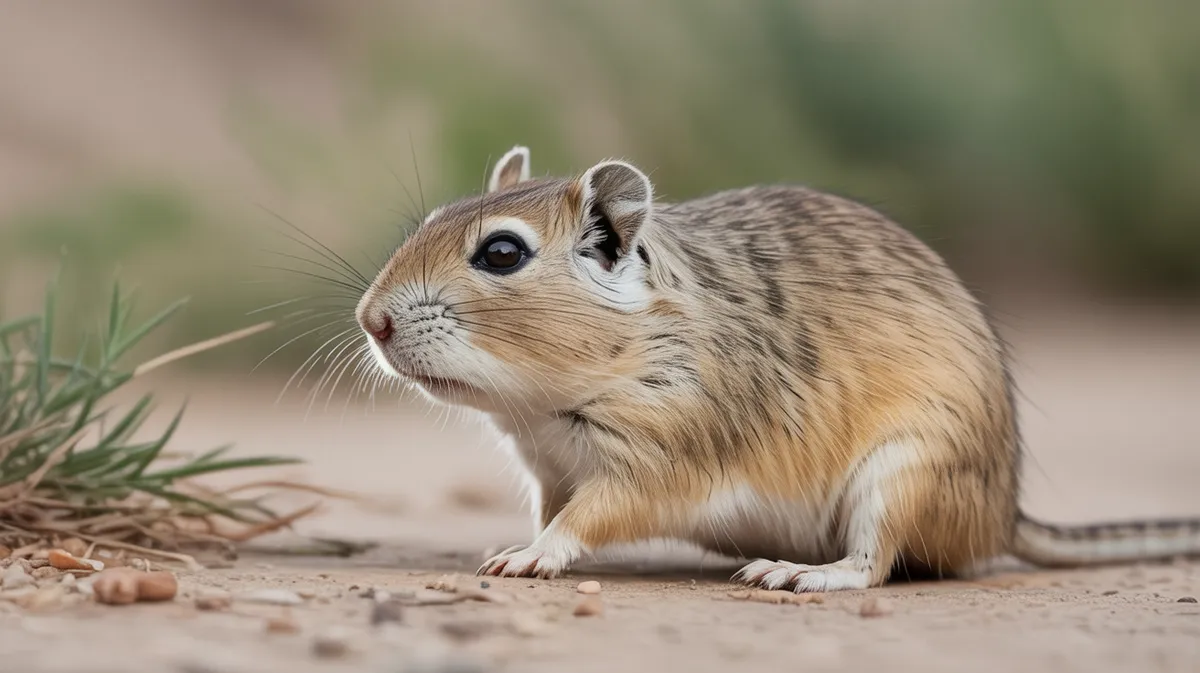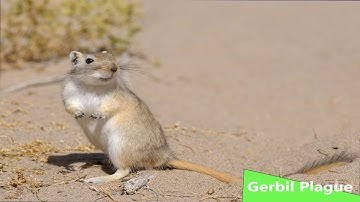
Mongolian Gerbil
Meriones unguiculatus

Meet the Mongolian Gerbil
The Mongolian gerbil is a small, burrowing rodent native to the dry grasslands and deserts of Central Asia, particularly Mongolia and northern China. Recognized for its long, furry tail and large, dark eyes, this species is highly social and often lives in large colonies with complex tunnel systems. Gerbils are known for their energetic and inquisitive behavior, making them popular pets worldwide. They are adapted to arid environments and can survive with minimal water by deriving moisture from their food.
Classification
Mammal
Habitat
Desert and grassland
Diet
Omnivore
Lifespan
2–4 years
Conservation
Least Concern
Weight
60–130 grams
📖Fascinating Facts
Expert Burrowers
Gerbils construct extensive underground tunnel systems that can reach up to 6 meters in length, helping them evade predators and extreme temperatures.
Ever-growing Teeth
Like all rodents, gerbils’ incisors grow continuously throughout their lives and must be worn down by gnawing.
Minimal Odor
Gerbils produce little urine and have almost no natural body odor, a trait that helps them conserve water and avoid detection in the wild.
📋Detailed Description
The Mongolian gerbil (Meriones unguiculatus) is a small, robust rodent characterized by a compact body measuring 110–135 mm in length, with a proportionally long, densely furred tail of 95–120 mm that aids in balance and thermoregulation. Its pelage is typically sandy-brown dorsally, blending with the arid steppe and desert environments of Mongolia and northern China, while the ventral side is paler. The species exhibits large, dark eyes adapted for crepuscular activity, and strong hind limbs that facilitate rapid, bounding locomotion across loose substrates. Ears are short and rounded, minimizing water loss. Mongolian gerbils are highly social, living in extended family groups within complex burrow systems that can reach depths of up to 1.5 meters and include multiple entrances, nesting chambers, and food storage areas. Their incisors are ever-growing, suited for gnawing tough plant material and seeds. Gerbils communicate through a range of vocalizations, foot drumming, and scent-marking, using specialized abdominal glands. Their metabolic adaptations allow them to survive on minimal water, extracting moisture efficiently from seeds and plant matter. In the wild, they are primarily active during dawn and dusk (crepuscular), reducing predation risk and exposure to extreme temperatures.
💡 Did you know?
Despite being called 'desert rats' in some regions, Mongolian gerbils are not true rats and belong to a distinct subfamily of rodents.
🔬Research & Sources
Wikipedia Summary
The Mongolian gerbil or Mongolian jird is a rodent belonging to the subfamily Gerbillinae. Their body size is typically 110–135 mm, with a 95–120 mm tail, and body weight 60–130 g, with adult males larger than females. The animal is used in science and research or kept as a small house pet. Their use in science dates back to the latter half of the 19th century, but they only started to be kept as pets in the English-speaking world after 1954, when they were brought to the United States. However, their use in scientific research has fallen out of favor.
Last Modified: 5/18/2025
🎭Behavior & Social Structure
Mongolian gerbils display a rich repertoire of social behaviors, including grooming, play-fighting, and communal nesting. They are primarily granivorous, foraging for seeds, roots, and green plant material, but will opportunistically consume insects. Foraging is often a group activity, with individuals taking turns as sentinels to watch for predators such as birds of prey and snakes. Gerbils exhibit food hoarding behavior, storing seeds in their burrow chambers for periods of scarcity. Communication is multifaceted: ultrasonic vocalizations are used by pups and during courtship, while adults employ foot drumming as an alarm signal or territorial display. Scent-marking with their ventral gland establishes territory and individual identity. Daily activity peaks at dawn and dusk, with periods of rest and social interaction in between. Aggression can occur between unfamiliar adults, particularly males, but within established groups, social hierarchies are maintained with minimal conflict.
👶Reproduction & Life Cycle
Mongolian gerbils are seasonally polyestrous in the wild, with breeding typically occurring from early spring to late autumn, though in captivity, reproduction can occur year-round. Courtship involves chasing, grooming, and vocalizations. After successful mating, the gestation period lasts 24–26 days. Litters usually contain 4–7 pups, though extremes of 1–12 have been recorded. Neonates are altricial—blind, hairless, and weighing about 2–3 grams. Both parents participate in pup rearing, with the male assisting in nest maintenance and grooming. Pups open their eyes at around 16–20 days and are weaned by 21–28 days. Sexual maturity is reached at 9–12 weeks. High reproductive potential and rapid maturation contribute to their ecological success in unpredictable environments.
🛡️Adaptations & Survival
Mongolian gerbils possess several adaptations for arid environments: highly efficient kidneys concentrate urine to minimize water loss, and they rarely drink free water in the wild, relying on metabolic water from food. Their burrowing behavior provides stable microclimates, protecting them from temperature extremes and predators. The furred tail aids in balance and can be autotomized (shed) if grasped by a predator, though it does not regenerate. Their social structure enhances survival, enabling cooperative care of young and communal defense. Behavioral thermoregulation—such as basking or retreating to deeper burrow chambers—helps maintain optimal body temperature. Their incisors and jaw musculature are adapted for processing hard seeds and fibrous plant material.
🎨Cultural Significance
While not deeply embedded in traditional Mongolian folklore, gerbils have been recognized as part of the steppe fauna and occasionally referenced in local ecological knowledge. Their global significance increased in the 20th century as laboratory animals, especially in auditory and neurological research due to their well-developed hearing and susceptibility to epilepsy. Since the 1950s, they have become popular pets in Europe and North America, valued for their docile nature, ease of care, and engaging behaviors. They are sometimes featured in educational settings as model organisms for teaching mammalian biology and behavior.
🔬Recent Research & Discoveries
Mongolian gerbils have been extensively used in biomedical research, particularly in studies of epilepsy, stroke, auditory physiology, and infectious diseases. Their auditory range closely matches that of humans, making them valuable for hearing research. Recent genetic studies have sequenced the gerbil genome, providing insights into their evolutionary history and physiological adaptations to arid environments. Research has also focused on their social cognition, communication, and stress responses. However, their use in research has declined in favor of mice and rats, which offer more genetic tools and standardized strains. Ongoing studies continue to explore their microbiome, desert adaptation mechanisms, and potential as models for zoonotic disease transmission.
🎥Wildlife Videos

Gerbil Plague (Nature Documentary)
TheAnimalPortal #Animaldocumentary #Wildlife #Nature.
TheAnimalPortal

Wild Mongolia: Small wildlife of the steppe - gerbils in the wild & steppe polecat (3/4)
Wild gerbils and other smaller mammals can be found in the wild of the Mongolian steppe. We were looking for wildlife in the ...
Wildlife Impulse

Tiny Titans - The Fascinating Lives of Rodents | Full Documentary
From the lovable hamster to the detested rat, the hyperactive chipmunk to the giant capybara, rodents have taken over the planet, ...
Free High-Quality Documentaries

Documentary on rodents - gerbils
Join me as we explore the lives of these playful creatures.
arya

10 Gerbil Facts - The Mongolian Desert Rat - Animal a Day G Week
Welcome to Animal a Day's G Week. Every day this week will have an animal that starts with the letter G. Today we learn about the ...
Animal a Day

The Dance of the Mongolian Gerbil: A Night in the Life of a Desert Rodent
The Dance of the Mongolian Gerbil: A Night in the Life of a Desert Rodent Step into the mysterious realm of Mongolia's nocturnal ...
CuteAnimal_JC
🌍Habitat Information
The Mongolian Gerbil typically inhabits Desert and grassland environments. Mongolian Gerbils have adapted to their environments with specialized features and behaviors.
Primary Habitat:
Desert and grassland
More detailed habitat information will be available soon.
🛡️Conservation Status
The Mongolian Gerbil is currently classified as Least Concern. Conservation efforts are crucial for preserving this species for future generations.
Common Threats:
- 🏠Habitat loss and fragmentation
- 🌡️Climate change impacts
- 🎯Hunting and poaching
- 🏭Human-wildlife conflict
⚠️Threats & Conservation Challenges
Currently listed as Least Concern by the IUCN, Mongolian gerbils have stable populations across their range. However, localized threats include habitat degradation from overgrazing, agricultural expansion, and climate change, which may alter vegetation and burrow stability. In some regions, they are considered agricultural pests due to seed predation. Natural predators include raptors, foxes, and snakes. Human capture for the pet trade and laboratory use has had minimal impact on wild populations. Ongoing monitoring is necessary to detect potential declines linked to environmental changes or disease outbreaks.
🔬Scientific Classification
Scientific Name
Meriones unguiculatus
Classification Hierarchy
🔍 About Taxonomic Classification
Taxonomic classification is a hierarchical system used by scientists to classify and organize living organisms based on shared characteristics and evolutionary relationships.
The system moves from broad categories (Kingdom) to increasingly specific ones, with each animal's scientific name typically consisting of its Genus and species.
📝Community Notes
Share your observations and insights about the Mongolian Gerbil with our community of wildlife enthusiasts.
Join Our Community
Sign in to share your observations and connect with fellow wildlife enthusiasts.
Sign In to ContributeNo community notes yet
Be the first to share your observations about the Mongolian Gerbil!
Explore Mongolian Gerbil
Select a tab above to learn more about this amazing animal.
📸Photo Gallery
No photos available for this animal yet.
🌟Discover More Wildlife
Continue your journey of discovery with more fascinating animals from our database
